Radon systems work to diminish the volume of radon in your home. It’s crucial to have a proper system in place to protect your household since radon is both tasteless and odorless. Nevertheless, it’s incredibly harmful and is one of the leading causes of lung cancer. To make an informed decision, understand the difference between active and passive radon systems.
Active Radon Systems
An active system actively uses a fan to suction radon out of your home. Additionally, it has a monitoring system and a vent pipe extending from the soil under the bottom layer of the house to above the roof.
This method tends to be far more effective in almost every situation and is the only option for existing structures because it can handle high radon levels. Even though it’s permanent and always running, this system requires minimal maintenance, and the fan lasts up to 10 years.
Passive Radon Systems
A passive system uses natural pressure differentials and air currents to eliminate radon from your house without an active fan element. Many builders often install these systems during the construction process, and your home may have one already built-in. However, they must install it properly.
Passive systems may be a good addition but not a stand-alone option due to their inconsistent performance and lack of ability to handle high radon levels.
Testing Your Home
If you’re unsure about your home’s radon levels or haven’t had it tested within the past two years, it’s best to buy a home testing kit or hire a radon mitigation company to measure it for you. It’s vital to upgrade or install your radon system as soon as possible if the test measures high radon levels in your house.
Since radon typically flies under the radar due to it being completely odorless, it’s crucial to stay on top of testing your home every two years. Knowing the difference between active and passive radon systems helps you keep your family safe, and Affordable Radon Services is here to help keep Denver, CO, homes free of radon.


Recent Comments